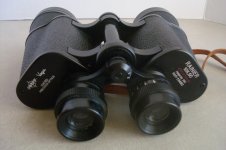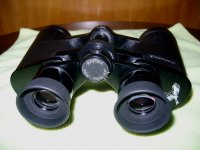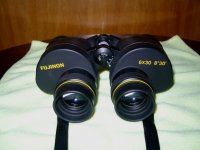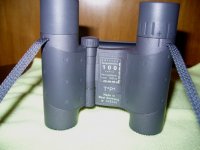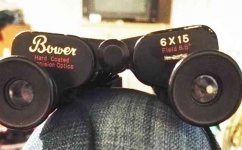-
Welcome to BirdForum, the internet's largest birding community with thousands of members from all over the world. The forums are dedicated to wild birds, birding, binoculars and equipment and all that goes with it.
Please register for an account to take part in the discussions in the forum, post your pictures in the gallery and more.
You are using an out of date browser. It may not display this or other websites correctly.
You should upgrade or use an alternative browser.
You should upgrade or use an alternative browser.
Vintage and Classic Binoculars (1 Viewer)
- Thread starter Simon S
- Start date
More options
Who Replied?garymh
Binocular Engineer
if anyone knows anything about it, be interested to know, for example I'm not even sure they are the same maker.
They are from the same maker - they both carry the KOMZ logo.
Gary.
They are from the same maker - they both carry the KOMZ logo.
Gary.
Thanks Gary.
I just picked these up and they are a bit different than my Swift Commodores 7X50 & Audubon 8.5X44 models. I'm not at all sure what the Vega means and wonder about their probable age. Any thoughts would be appreciated.
Vega was its own brand, and then was absorbed into the Swift lineup
as "Swift Vega". Compared to regular binoculars, they have a much sharper
focus near the field's edge and a very flat field overall (little bulging
or puckering), so it seems they have more elements in the eyepiece
that run-of-the-mill eyepieces. The focuser is very solid and smooth.
They are a cut above most, even in the Swift line. Swifts like Aerolites
aren't quite as good. Swift Saratogas are either similar or not as good,
depending on the size. Compared to the Audubon 8.5x44, the Audubon
rends a bit more towards extra field and the Vega towards sharper edges
with less field (unless it's a special x-wide model).
I see ads for the "Swift Vega" in the early 1960s, so just "Vega" should
be around the late 1950s.
10x50 is a rare size for Vegas. They would be great for long distance and
excellent for the night sky. Most Vegas stayed pretty clean inside. Not much
dust gets past their focuser tubes.
I see a picture of the 10x50 Rainier that says 1965.
It has the long striped knob and precision focuser piston.
That seems like a nice touch for long range.
Last edited:
I recent got the most extraordinary binoculars...
It's a Sears Model 6231, 8x50 (unusual), 430ft @ 1000yd (impressive),
a hefty, short layout for a 50mm, and it has an unusually great field (65 degrees afov)
Sweet spot is at least 65%, usable sharpness to 95%...
I haven't seen one like it before..
the real surprise is the eyepiece and field.
The J-numbers are JE40 and JB92
So:
JB 92 Hayashi Kokisha
...they made some Sans+Streiffe
Hard to find much else...
It's a Sears Model 6231, 8x50 (unusual), 430ft @ 1000yd (impressive),
a hefty, short layout for a 50mm, and it has an unusually great field (65 degrees afov)
Sweet spot is at least 65%, usable sharpness to 95%...
I haven't seen one like it before..
the real surprise is the eyepiece and field.
The J-numbers are JE40 and JB92
So:
JB 92 Hayashi Kokisha
...they made some Sans+Streiffe
Hard to find much else...
Last edited:
Highway Dog
Well-known member

O. N.
Does this Sears binoculars seem to be single coated? Are the reflections a bit muted on the eye pieces?
Thanks!
Rob A.
Does this Sears binoculars seem to be single coated? Are the reflections a bit muted on the eye pieces?
Thanks!
Rob A.
Yes....looks like single-coated/pale violet front and back.
The coatings inside the eyepiece show, and they are muted
in comparison with the final (outside) eyepiece surface, which
doesn't have a coating. That was the 'stylish' thing to do on many x-wides at the time.
They still seem surprisingly bright...probably an effect of the contrast.
I cleaned outer faces on the prisms only. The remaining smutz
is a few black particles, and since they absorb and don't scatter,
I leave them there. A miniscule loss. They are heavy...some plate brass,
and the prisms are honkers.
The coatings inside the eyepiece show, and they are muted
in comparison with the final (outside) eyepiece surface, which
doesn't have a coating. That was the 'stylish' thing to do on many x-wides at the time.
They still seem surprisingly bright...probably an effect of the contrast.
I cleaned outer faces on the prisms only. The remaining smutz
is a few black particles, and since they absorb and don't scatter,
I leave them there. A miniscule loss. They are heavy...some plate brass,
and the prisms are honkers.
WJC
Well-known member
Vega was its own brand, and then was absorbed into the Swift lineup
as "Swift Vega". Compared to regular binoculars, they have a much sharper
focus near the field's edge and a very flat field overall (little bulging
or puckering), so it seems they have more elements in the eyepiece
that run-of-the-mill eyepieces. The focuser is very solid and smooth.
They are a cut above most, even in the Swift line. Swifts like Aerolites
aren't quite as good. Swift Saratogas are either similar or not as good,
depending on the size. Compared to the Audubon 8.5x44, the Audubon
rends a bit more towards extra field and the Vega towards sharper edges
with less field (unless it's a special x-wide model).
I see ads for the "Swift Vega" in the early 1960s, so just "Vega" should
be around the late 1950s.
10x50 is a rare size for Vegas. They would be great for long distance and
excellent for the night sky. Most Vegas stayed pretty clean inside. Not much
dust gets past their focuser tubes.
I see a picture of the 10x50 Rainier that says 1965.
It has the long striped knob and precision focuser piston.
That seems like a nice touch for long range.
Early on, with my return to BirdForum, we went head-to-head a few times. However, just as I get tweaked when I see someone saying more than I think he knows from first-hand experience, I am also EAGER to say "good job."
And although I'm sure you would get frustrated having me support what you have to say as much as I don't need your blessing on my words, I would like to say, "excellent job" on this post. :t:
Bill
Last edited:
It takes time, but I change, work at getting better...and more coherent, hopefully.
Of course, my learning is best for "sleeper" models with a lot of hidden value, my pets.
They still shine after 30-60 yrs. If the EPs are superb they can clobber
many middling pairs today. Vegas, Tower 7x35//7.1s, Scope Custom 3010s,
early Bushnell Banner narrows are in a category I think of as "Kowa Prominar chasers".
Dark, clean, advanced eyepiece driven.
You need a long parade of models and parts in order to decode the history of the J-Bins.
I should collect the emerging advertisement data, though...the prices back when.
I should quit while I'm ahead
Unfortunately, binoculars have depressed values along with most
middle-class collectibles the past 20 yrs. Flip side is, if you're savvy
and handy you can score some great stuff. Another thing: binoculars
don't age anywhere near as badly as motorcycles and cars. (at least,
the good old mostly-meatl binocs).
Of course, my learning is best for "sleeper" models with a lot of hidden value, my pets.
They still shine after 30-60 yrs. If the EPs are superb they can clobber
many middling pairs today. Vegas, Tower 7x35//7.1s, Scope Custom 3010s,
early Bushnell Banner narrows are in a category I think of as "Kowa Prominar chasers".
Dark, clean, advanced eyepiece driven.
You need a long parade of models and parts in order to decode the history of the J-Bins.
I should collect the emerging advertisement data, though...the prices back when.
I should quit while I'm ahead
Unfortunately, binoculars have depressed values along with most
middle-class collectibles the past 20 yrs. Flip side is, if you're savvy
and handy you can score some great stuff. Another thing: binoculars
don't age anywhere near as badly as motorcycles and cars. (at least,
the good old mostly-meatl binocs).
Last edited:
Bausch&Lomb custom, a Fujimon and a Zeiss
Not been on for awhile, health issues, but thought I would revive this thread, as having not bought a binocular for the collection for ages, I have suddenly bought three, a nice old B&L 8X36 Custom, National Audubon model, which I think a bargain at £15, original case and boxed. Very good optics, clear and sharp, and a very solid well made binocular. Cons? well, average FOV of 340ft@1000yds, and when looking into brightness, like a bright sky, some flare right at the edge of FOV, like a halo, but very good at dusk and I think a popular binocular in it's day. Second, a Fujinon 6x30 IF which I think is thought to be one of the best 6x IF Porros. It is a well made instrument, and optically sharp as a tack. Obviously a marine glass given the rubber armor and waterproofing, FOV 435FT@1000YDS. However, comparing it with my 6.5x32 Minox BD IF roof there is not much in it and the Minox would have been half the price when both new.
Cons? Heavy, and a slightly dark image, maybe has a tint. Last, a Zeiss Design Selection 8x20B T*P*, limited edition 100 anniversary model, sharp and bright for a compact, no cons really, about the same as other Zeiss 8x20s overall although does not fold as small in its strange shaped plastic case. Really a nice collectable. Hope interesting.
www.flickr.com/photos/95019762@N07/with/19027154519/
Not been on for awhile, health issues, but thought I would revive this thread, as having not bought a binocular for the collection for ages, I have suddenly bought three, a nice old B&L 8X36 Custom, National Audubon model, which I think a bargain at £15, original case and boxed. Very good optics, clear and sharp, and a very solid well made binocular. Cons? well, average FOV of 340ft@1000yds, and when looking into brightness, like a bright sky, some flare right at the edge of FOV, like a halo, but very good at dusk and I think a popular binocular in it's day. Second, a Fujinon 6x30 IF which I think is thought to be one of the best 6x IF Porros. It is a well made instrument, and optically sharp as a tack. Obviously a marine glass given the rubber armor and waterproofing, FOV 435FT@1000YDS. However, comparing it with my 6.5x32 Minox BD IF roof there is not much in it and the Minox would have been half the price when both new.
Cons? Heavy, and a slightly dark image, maybe has a tint. Last, a Zeiss Design Selection 8x20B T*P*, limited edition 100 anniversary model, sharp and bright for a compact, no cons really, about the same as other Zeiss 8x20s overall although does not fold as small in its strange shaped plastic case. Really a nice collectable. Hope interesting.
www.flickr.com/photos/95019762@N07/with/19027154519/
Attachments
Last edited:
Nixterdemus
Well-known member
"This Thread is more than 793 days old. It is very likely that it does not need any further discussion and thus bumping it serves no purpose."
Respectfully, I disagree. :smoke:
Such a nice informative thread that cries unto me, "Resurrection"! Not sure why it fell to the wayside, but enough reflecting.
I've researched various sites on the Ross Stepray, 12x50 I.F. SN 146874, and they say the reign was 1934-1948/49 for the I.F. The C.F. continued on into the 60's.
SN all Ross models
125000 to 133000 - 1945 to 1950
133000 to 270000 - 1950 to 1954
Fifteen thousand and change units after the 1950 cutoff seems quite a leap. So, is it merely some spare parts lying around a few years later assembled or is it a Frankenbin that once was C.F.?
SN 146874 would appear to be manufactured perhaps in 1951.Which if originally an I.F. could be one of the last though at any given time w/I.F. oculars/spindle NOS parts I suppose another run of sorts wouldn't be entirely out of the question. It's my understanding that save the oculars and spindle w/focus wheel the I.F. and C.F. were identical.
Even though the I.F. line was dropped, potentially up to three years prior, would Ross have had that much inventory in stock?
Thoughts?
Respectfully, I disagree. :smoke:
Such a nice informative thread that cries unto me, "Resurrection"! Not sure why it fell to the wayside, but enough reflecting.
I've researched various sites on the Ross Stepray, 12x50 I.F. SN 146874, and they say the reign was 1934-1948/49 for the I.F. The C.F. continued on into the 60's.
SN all Ross models
125000 to 133000 - 1945 to 1950
133000 to 270000 - 1950 to 1954
Fifteen thousand and change units after the 1950 cutoff seems quite a leap. So, is it merely some spare parts lying around a few years later assembled or is it a Frankenbin that once was C.F.?
SN 146874 would appear to be manufactured perhaps in 1951.Which if originally an I.F. could be one of the last though at any given time w/I.F. oculars/spindle NOS parts I suppose another run of sorts wouldn't be entirely out of the question. It's my understanding that save the oculars and spindle w/focus wheel the I.F. and C.F. were identical.
Even though the I.F. line was dropped, potentially up to three years prior, would Ross have had that much inventory in stock?
Thoughts?
"Even though the I.F. line was dropped, potentially up to three years prior, would Ross have had that much inventory in stock?"
There would have been a lot of parts interchangeability between the Ross 7x50, 10x50 and 12x50 Porro II IF and CF models. Other than CF or IF I think eyepieces would be the only major differences between them. Also, the 10x50's eyepiece housing is different than that of the 7x50 and 12x 50 models. Prisms were probably the same between models and the objectives may have been too. Ross introduced air spaced Porro II prisms in some of these models but I don't think this happened until the 1960's.
There would have been a lot of parts interchangeability between the Ross 7x50, 10x50 and 12x50 Porro II IF and CF models. Other than CF or IF I think eyepieces would be the only major differences between them. Also, the 10x50's eyepiece housing is different than that of the 7x50 and 12x 50 models. Prisms were probably the same between models and the objectives may have been too. Ross introduced air spaced Porro II prisms in some of these models but I don't think this happened until the 1960's.
Ross had a large amount of spare parts when eventually the stock was sold to various dealers.
Unfortunately it was all jumbled up and I couldn't find much of interest to me.
Some of these dealers had enormous amounts of older optics. I think most of them also closed eventually. At least three anyway.
A lot ended up in skips going to landfill I think.
The Ark Royal aircraft carrier was bought by 5 firms. It cost a great deal to move her. The flight deck was high quality steel.
I got some 24 inch, I think, high quality bearings from gun turrets that were eventually used for movable observatories.
They cost £25 each from memory and I parted with them for the same amount to enthusiasts.
Probably thousands of uncoated aerial lenses at a major optics maker were use as infill for a car park, when they became more or less worthless.
Unfortunately it was all jumbled up and I couldn't find much of interest to me.
Some of these dealers had enormous amounts of older optics. I think most of them also closed eventually. At least three anyway.
A lot ended up in skips going to landfill I think.
The Ark Royal aircraft carrier was bought by 5 firms. It cost a great deal to move her. The flight deck was high quality steel.
I got some 24 inch, I think, high quality bearings from gun turrets that were eventually used for movable observatories.
They cost £25 each from memory and I parted with them for the same amount to enthusiasts.
Probably thousands of uncoated aerial lenses at a major optics maker were use as infill for a car park, when they became more or less worthless.
Last edited:
Nixterdemus
Well-known member
Flash from the past an e-mail reply to, Vintage and Classic Binoculars.
I'm quite fond of the Stepray. Probably would have preferred the C.W. over the I.F. though I consider that minor. For me the porro II design svelte bodies embraced me hands as an extension of them instead of feeling as gripping. Perhaps if C.F. hands would move to a differing position.
Believe I read somewhere that the prism was coated as well Not comparable by today's standards but a coat just the same is better than naught. Only knowing what I read I'm not sure if I could detect cemented vs air spaced prism w/o tearing it apart. Would taking off a front plate reveal such w/o further steps? Two screws aren't much of a step even for me.
Thanks for the replies.
I'm quite fond of the Stepray. Probably would have preferred the C.W. over the I.F. though I consider that minor. For me the porro II design svelte bodies embraced me hands as an extension of them instead of feeling as gripping. Perhaps if C.F. hands would move to a differing position.
Believe I read somewhere that the prism was coated as well Not comparable by today's standards but a coat just the same is better than naught. Only knowing what I read I'm not sure if I could detect cemented vs air spaced prism w/o tearing it apart. Would taking off a front plate reveal such w/o further steps? Two screws aren't much of a step even for me.
Thanks for the replies.
Last edited:
Nixterdemus
Well-known member
Once looking at the cage would it be obvious if air spaced or cemented? If air spaced should I be able to see the space? Such is my ignorance, but I did pull one cover a few years ago. I don't recall the prisms being cemented, yet I've slept since then.
------
I'm snooping 'round for information on a Busch Stellux 8x20 compact w/DRP inside of triangle on right prism cover. The two L's are staggered w/half space twixt the twain. The DRP triangle on the left is the same. Both sides above that have the Starburst that is seen on the Busch Terlux models above the triangles. Likewise Germany raised on the IPD cap & -56, -64,-70.
Bell shaped bakelite eye cups screw into metal checkered rings. Right diopter has 0 - + w/4 hash marks on either side. The design is almost a reverse porro. The porro moves from eyepiece to objective on the vertical. Side lug straps and a rather lengthy focus wheel.
Leather strap is 5/16" wide as well the same for the brass ocular extensions. SN 75073 stamped underneath front left frame. A bit of PC the distortion is well behaved especially in a vertical pan. In part no doubt from small fov though even chainlink fence shows precious little in horizontal pan.
Dim could use a cleaning, but in bright light for a 8x20 approximately a century old the view astounded me. I looked at the T-bar 100 yds off and could easily distinguish the fence lugs at top painted silver highlighted by full sun. I'm about 63mm IPD and from there the compact is 3.5" tip of cups to tip of objective extensions & 4.75 front barrel to barrel being widest.
I've seen the same eyecups on a different model Busch in a 1913 German civilian advertisement.
US Army Type D. Planned in 1910. Magnification 8, field of view 5 degrees 40 minutes, estimated cost $27. 1916 issue, Busch 8-power Stellux, 1.75 inch objective.
The Signal Corps Storage Catalogue (1920): Type E-11 - "prismatic; Busch 8-power 'Stellux'; object lens, .75-inch...formally Designated type D"
The latter shows objective of 0.75 which is very close to 20mm. The former type D 1916 is listed as 1.75".
One or the other misprint/typo? I haven't the foggiest. However, my example C.F. surely was designed for the civilian market.
-----
As an afterthought I have another pair of vintage bins 9x63 I. F. that may or may not be completely gubbermint issue. I've little doubt the 7x50 body was issue. They're painted black. I wish to peer beyond the Krylon Kustom w/o damaging whatevah might linger beneath. I was considering rubbing alcohol because of the fast evaporation. I'm all ears to any suggestions for removing the top layer of paint
I can see an outline on the left prism cover. There's 5 flathead prism cover screws. The highest one has an insignia of sorts, to its right & slightly down, that I can barely see, yet the outline is fairly clear. It's either an arrowhead pointing up notched inward 2/3 way down leaving the smaller part that would attach to an arrow shaft or it's an eagle profile w/head turned to the outside and talons are affixed to a shield somewhat heart shaped.
Besides the barrel extensions an interesting armour. There is no armour. It has a light even pattern consistent of being air sprayed. Appears almost as a glue gun though not sticky. Whatever it is it is nothing as the sprayed frism covers. Perhaps the same gent that applied blk matte to the objective covers.
------
I'm snooping 'round for information on a Busch Stellux 8x20 compact w/DRP inside of triangle on right prism cover. The two L's are staggered w/half space twixt the twain. The DRP triangle on the left is the same. Both sides above that have the Starburst that is seen on the Busch Terlux models above the triangles. Likewise Germany raised on the IPD cap & -56, -64,-70.
Bell shaped bakelite eye cups screw into metal checkered rings. Right diopter has 0 - + w/4 hash marks on either side. The design is almost a reverse porro. The porro moves from eyepiece to objective on the vertical. Side lug straps and a rather lengthy focus wheel.
Leather strap is 5/16" wide as well the same for the brass ocular extensions. SN 75073 stamped underneath front left frame. A bit of PC the distortion is well behaved especially in a vertical pan. In part no doubt from small fov though even chainlink fence shows precious little in horizontal pan.
Dim could use a cleaning, but in bright light for a 8x20 approximately a century old the view astounded me. I looked at the T-bar 100 yds off and could easily distinguish the fence lugs at top painted silver highlighted by full sun. I'm about 63mm IPD and from there the compact is 3.5" tip of cups to tip of objective extensions & 4.75 front barrel to barrel being widest.
I've seen the same eyecups on a different model Busch in a 1913 German civilian advertisement.
US Army Type D. Planned in 1910. Magnification 8, field of view 5 degrees 40 minutes, estimated cost $27. 1916 issue, Busch 8-power Stellux, 1.75 inch objective.
The Signal Corps Storage Catalogue (1920): Type E-11 - "prismatic; Busch 8-power 'Stellux'; object lens, .75-inch...formally Designated type D"
The latter shows objective of 0.75 which is very close to 20mm. The former type D 1916 is listed as 1.75".
One or the other misprint/typo? I haven't the foggiest. However, my example C.F. surely was designed for the civilian market.
-----
As an afterthought I have another pair of vintage bins 9x63 I. F. that may or may not be completely gubbermint issue. I've little doubt the 7x50 body was issue. They're painted black. I wish to peer beyond the Krylon Kustom w/o damaging whatevah might linger beneath. I was considering rubbing alcohol because of the fast evaporation. I'm all ears to any suggestions for removing the top layer of paint
I can see an outline on the left prism cover. There's 5 flathead prism cover screws. The highest one has an insignia of sorts, to its right & slightly down, that I can barely see, yet the outline is fairly clear. It's either an arrowhead pointing up notched inward 2/3 way down leaving the smaller part that would attach to an arrow shaft or it's an eagle profile w/head turned to the outside and talons are affixed to a shield somewhat heart shaped.
Besides the barrel extensions an interesting armour. There is no armour. It has a light even pattern consistent of being air sprayed. Appears almost as a glue gun though not sticky. Whatever it is it is nothing as the sprayed frism covers. Perhaps the same gent that applied blk matte to the objective covers.
Last edited:
birdazzLED
Well-known member
I just took delivery on a pair of Bower 6x15, No.1789 (Field 8.5 degrees)
and I'm really surprised. I had sworn off that size because of all the bare-knuckle
silver binocs whose contrast never quite cleaned up for haze.
These had two boxes for the prisms, a high-precision focuser, and the
"front-spectacles" yoke for the objectives, just like mini Bushnell Customs.
I have an eye out for features descended from the smaller "Mirador-made"
binoculars that became the Custom line. Mirador made cool officer and spy
binocs in WW2 but they died in the early 50s.
Anyway. these dinky 6x15s are sharp and have contrast that shames a lot
of other binocs. Totally jars my assumptions about size. Movement is
silky smooth and the image is almost as crisp as the smaller customs.
They can't do miracles with brightness at 6x15...they are a bit dim.
Love the 8.5 degree FOV...sure beats the usual. Real "teeny-Customs".
The pure-luck part was: no nicotine or mold. I don't even have to go into
these guys... Surface-cleaned. They have a faint violet hard coating.
Took a chance. I have a pile of chances that didn't work out..
but these did! Awesome pocket glancers. They just need a little daylight.
I just now bought these 6x15 at goodwill and a search landed me here. They need a little cleaning and it's a little loose but I can't complain for $6.99. Are they worth sending it somewhere to fix?
Attachments
Similar threads
- Replies
- 48
- Views
- 3K
Users who are viewing this thread
Total: 2 (members: 0, guests: 2)




